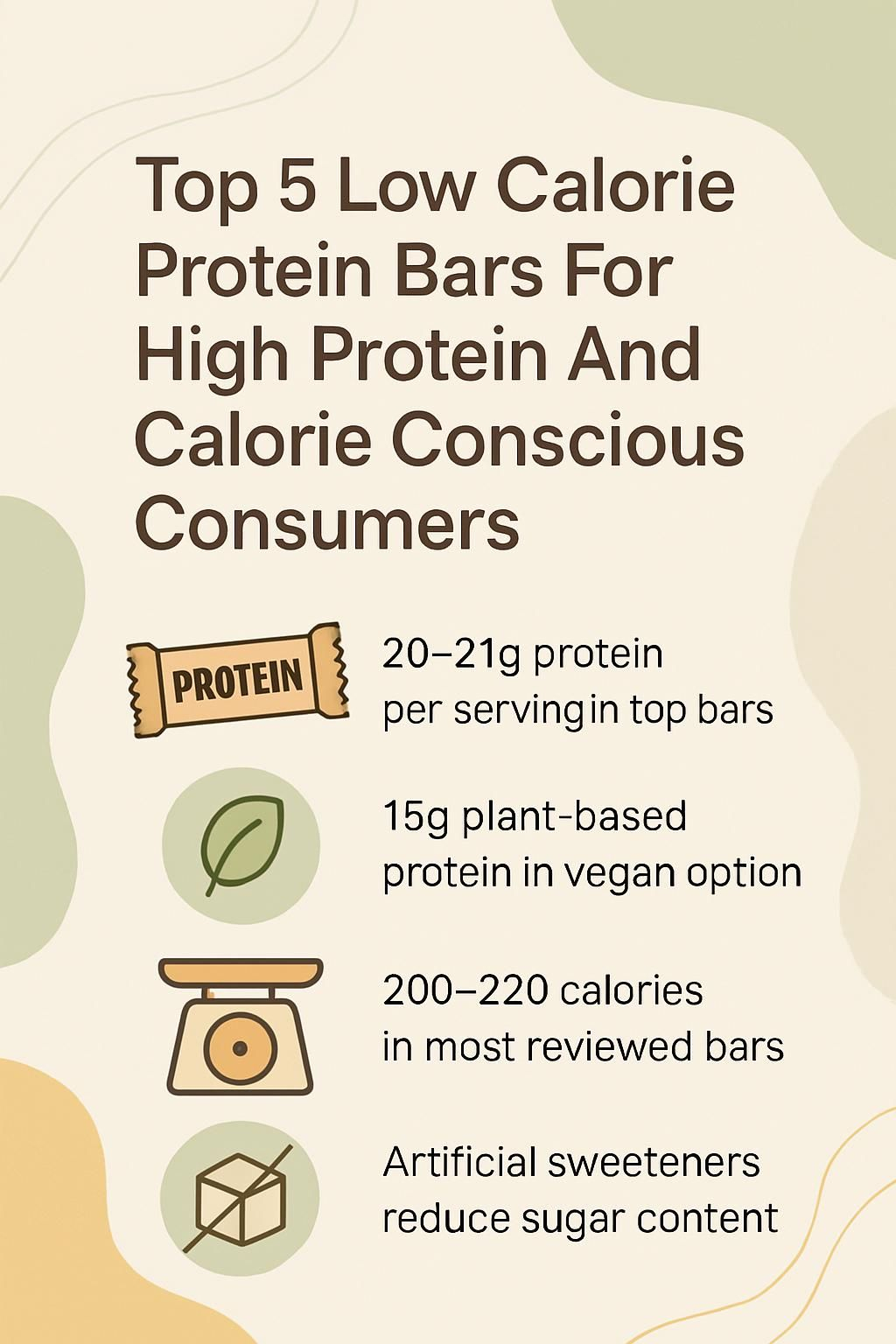Top 5 Low Calorie Protein Bars For High Protein And Calorie Conscious Consumers
Our Nutrition Assistant AI Suite will transform your body. You will lose fat, get toned, and build muscle. Gain confidence and optimal health.
Searching for low calorie protein bars that also taste good can be tiring. The right protein bar helps you stay on track with fewer calories, steady energy, and solid protein for fullness.
In this guide, you will find the top 5 options that keep protein high and calories modest. You will also learn how to pick a bar that fits your diet, your taste, and your budget.
Key Takeaways
- Barebells, Pure Protein, and Quest bars provide 20 to 21 g protein with about 180 to 210 calories per serving.
- No Cow Protein Bar is vegan and gluten-free, with 15 g plant-based protein and 10 g fiber, at roughly 200 to 220 calories.
- RXBar has 10 to 12 g protein from egg whites and nuts, and higher natural sugar from dates than other bars here.
- Many bars use sugar alcohols like maltitol or erythritol to lower sugar while keeping sweetness.
- High protein bars support weight control by increasing fullness and helping maintain muscle during calorie control.

Benefits of Low-Calorie Protein Bars

Low calorie protein bars let you manage total calories while hitting daily protein targets. A well-made bar serves as a quick snack without loads of added sugar or empty calories.
How do low-calorie protein bars help with weight loss?
Choosing the best protein bars for lower calories can reduce hunger and cravings. Each bar comes portioned, which makes tracking easier during a weight loss plan.
Protein slows digestion and signals fullness hormones, including GLP-1, peptide YY, and cholecystokinin. These signals help you feel satisfied longer and may lower ghrelin, the hunger hormone. Research in nutrition journals shows higher protein supports appetite control and lean mass during dieting.
Aim for 1.2 to 1.6 grams of protein per kilogram of body weight per day. At 80 kg, that equals about 96 to 128 grams daily. Choosing bars with at least 14 g of protein helps you reach that range.
I kept a box of Barebells at my desk. A 180 to 200 calorie bar in the afternoon stopped candy cravings and kept dinner portions reasonable.
Protein bars helped me control my hunger, so I could focus on eating healthy meals and keeping my calorie intake in check.
Can low-calorie protein bars satisfy cravings without adding excess calories?
Yes. Many bars taste like dessert but keep calories reasonable. Brands such as Barebells or Quest offer flavors like Birthday Cake, Chocolate Fudge Brownie, and Lemon Cheesecake. Most range from 150 to 210 calories per bar.
Sugar substitutes and sugar alcohols add sweetness without many calories. Protein, often 10 g or more, and fiber, sometimes 7 g or more, work together to keep you full longer than cookies or candy.
Single-serve wrappers also limit mindless snacking. I often reach for a Blueberry RXBar or a Pure Protein bar when I want something sweet yet still want to manage calories.
How can low-calorie protein bars increase your daily protein intake?
Protein bars add a lot of protein without many calories. Barebells and Pure Protein supply about 20 g per bar. RXBar gives 10 to 12 g, and No Cow offers 15 g per bar.
Two bars can deliver up to 40 g of protein, which helps with muscle building, recovery, and weight loss plans. They fit well after a workout or during busy days, thanks to steady protein and modest sugars.
Some bars use plant-based protein like brown rice protein or pumpkin seed protein. These help people with food sensitivities or those following a plant-based diet meet daily needs.
Popular flavors include chocolate brownie, peanut butter chocolate chip, and oatmeal chocolate chip. Variety can keep your plan enjoyable.
Why are low-calorie protein bars a convenient snack option?
Grab, unwrap, and eat on the way to work or class. Bars are shelf-stable, travel well, and fit in a gym bag, purse, or desk. Buying variety packs at Costco or Amazon keeps you stocked.
I keep Barebells and other low carb bars in my car for busy mornings. No blender or fridge needed, unlike some protein powder options. With around 10 to 21 g of protein and fewer than 200 calories, these snacks fit calorie restriction plans and support hunger control.
How to Choose the Best Low-Calorie Protein Bar
Picking the right bar is simpler if you focus on protein content, calories, sweeteners, and your dietary needs.
What protein content should I look for in a protein bar?
Choose at least 10 g of protein per bar. If you want stronger hunger control or post-workout support, look for 15 to 21 g of high quality protein.
Pure Protein offers about 20 to 21 g, and No Cow Dipped has about 15 g. RXBar ranges from 10 to 12 g. Orgain Plant-Based Protein Bar has 10 g.
Type matters. Whey protein is complete, meaning it contains all essential amino acids for muscle repair. Plant-based blends can still work well, especially if they combine different sources. Check labels for sources like whey isolate or casein, and for plant blends that lift the total amino acid quality.
How many calories are ideal in a low-calorie protein bar?
About 200 calories offers a good balance between fullness and calorie control. Bars under 150 calories may not satisfy everyone, which could lead to extra snacking.
Pure Protein sits around 180 to 200 calories. Bulletproof and Orgain offer 150 calorie options, which are lighter choices, yet may be less filling. Higher calorie bars, such as Perfect Bar at 330 or more calories, do not fit low calorie goals as well.
Most options for calorie control fall between 150 and 220 calories. For steady fullness without going over, pick bars under 200 calories and check labels to confirm serving sizes.
What types of sugar and sweeteners are used in protein bars?
Bars often use sugar alcohols like sorbitol, maltitol, and erythritol to keep sugar low. These reduce net carbs and calories, though more than 10 g per day can upset your stomach.
Some brands use artificial sweeteners. Others keep real sugar very low. Think! and Bulletproof have about 1 g of sugar per serving. RXBar relies on dates, a whole food sweetener, instead of syrup.
Scan labels for coconut sugar, caramel, cocoa butter, or other added sugars so you can match your plan and your tolerance.
How do dietary restrictions and preferences affect protein bar choice?
Food allergies, plant-based preferences, and lower carb needs can shape your choice. No Cow Protein Bar is vegan, dairy-free, and gluten-free. Orgain Plant-Based is organic, plant-based, gluten-free, and soy-free.
If you track carbs, you might want keto-friendly choices. Dang Bar is higher in healthy fats and works for low carbohydrate plans. Barebells may contain traces of gluten, so avoid them if you have celiac disease.
I once grabbed a bar that looked healthy, then noticed it had milk powder. Now I always check for allergens and ingredients that fit my plan.
What texture and taste should I expect from a good protein bar?
Texture should be pleasant and easy to chew. Pure Protein can taste chewy or a bit chalky. RXBar is chewy and sticky because of dates.
Fit Crunch is softer and richer, like a candy bar. Orgain Plant-Based can feel drier or slightly gritty because of fiber. Taste ranges from nut butter flavors to dessert flavors like chocolate caramel or chocolate almond.
Variety packs on Amazon can help you sample different textures and flavors before you buy a full box. Preferences differ, so try a few before settling on your daily pick.
Barebells Protein Bar
Barebells tastes like a treat while delivering serious protein for calorie-conscious plans, a rare combo in a convenient bar.
What are the key features of Barebells Protein Bar?
Each bar supplies 20 g of high quality, complete protein to support muscle and curb hunger. There is no added sugar and no palm oil, which helps keep calories lower than candy bars.
Barebells also offers vegan options. Flavors such as Coco Caramel Almond, Pumpkin Spice Latte, and Lemon Cheesecake keep things fun without wrecking your macros.
The brand launched in Sweden in 2016 and now sells in more than 40 markets. On Amazon, prices often range from about $27.99 to $30.99 per 12 pack or variety pack. I like the Peanut Butter Cup flavor before a workout for a quick, filling snack.
What are the pros and cons of Barebells Protein Bar?
Barebells delivers high protein and good flavor for a modest calorie count. Review the upsides and tradeoffs before adding it to your routine.
- 20 g of protein per bar supports muscle and daily protein targets.
- No added sugar helps control cravings without extra calories.
- No palm oil may appeal to eco-conscious shoppers.
- Vegan alternatives are available for dairy-free or plant-based diets.
- Lots of flavors, including seasonal picks like Pumpkin Spice Latte and Raspberry Cream.
- Limited editions can sell out quickly on Amazon and in stores.
- Individually wrapped bars are easy for on-the-go snacks or post-workout recovery.
- Some flavors may contain traces of gluten, not a fit for strict gluten-free needs.
- Typical price near $29.99 per 12 pack, with occasional dips to about $27.99.
- Not every flavor stays in stock year-round, and bestsellers can disappear fast.
- If you avoid artificial ingredients, read labels since not all flavors meet that preference.
Choose Barebells if you want a filling protein bar that keeps calories under control and offers dessert-like flavors.
Pure Protein Bar
Pure Protein offers strong protein per calorie, a practical choice for daily snacking or workout support.
What are the key features of Pure Protein Bar?
Each bar gives 20 to 21 g of protein and about 180 to 200 calories. This ratio supports hunger control without pushing your calorie budget.
The brand offers many flavors, and the cost often lands near $1.40 per bar, which helps with budget planning. These bars use sweeteners like sugar, maltitol, and corn syrup to improve taste.
You can buy them widely, including Amazon. Experts often rank Pure Protein among the best protein bars for weight loss because it offers strong protein with portion control.
Packs commonly include six bars that fit busy schedules and on-the-go needs.
What are the pros and cons of Pure Protein Bar?
Pure Protein is a popular pick for people who want steady protein with fewer calories.
- About 20 g of protein per serving helps raise daily protein intake.
- Affordable and easy to find on Amazon and in many stores.
- Variety packs let you try different flavors without buying full boxes of one kind.
- Lower sugar than many snacks, helpful for calorie control.
- Texture can be chewy or chalky, and some flavors taste more artificial than others.
- Contains sugar alcohols like maltitol and corn syrup, which may bother sensitive stomachs.
- Uses artificial sweeteners in several flavors, which some people dislike.
- Certain varieties reach 28 g of protein, which supports post-workout recovery.
- Not all flavors are gluten-free or vegan, so check labels for any allergens.
- Six count packages, about 13.76 ounces total, are convenient for travel and work.
Next, see how No Cow compares if you want plant-based protein with more fiber.
No Cow Protein Bar
No Cow is a dairy-free choice with solid protein and fiber for people who prefer plant-based snacks.
What are the key features of No Cow Protein Bar?
No Cow bars are gluten-free, dairy-free, and vegan. Each bar supplies 15 g of protein to support daily needs on a plant-based diet.
With 10 g of fiber, these bars help with hunger control and digestion. Each serving has roughly 200 to 220 calories.
Total sugar is about 5 g per bar. This nutrition profile works for people who want less sugar with steady energy. Expect to pay about $2.75 per bar in many variety packs on Amazon.
Each package often measures 5.63 by 3.58 by 2.24 inches for a six count. Use GTIN 850064303230 or ASIN B0DP5JZ8RT to locate it online.
What are the pros and cons of No Cow Protein Bar?
No Cow stands out for plant-based protein and high fiber, with a few tradeoffs to consider.
- 15 g of protein supports muscle repair and active lifestyles.
- 10 g of fiber per bar helps you stay full and supports regularity.
- About 5 g sugar supports better energy control during the day.
- Vegan, gluten-free, and dairy-free, a fit for many allergies and preferences.
- Some reviews mention digestive discomfort from sugar alcohols if eaten in excess.
- Texture can feel less creamy without dairy, and flavors vary in taste appeal.
- Higher price than some competitors, which can limit frequent purchases.
- Flavor variety is smaller compared with larger brands.
- Great option for strict diets that avoid animal products with extra calories.
- Often sold in six count boxes, about 13.76 ounces, under ASIN B0DP5JZ8RT.
- Track your tolerance to sugar alcohols if you plan to eat more than one bar daily.
Quest Nutrition Protein Bar
Quest delivers high protein and low sugar with dessert-inspired flavors, a helpful combo for calorie control.
What are the key features of Quest Nutrition Protein Bar?
Each bar contains 20 to 21 g of protein and about 190 to 210 calories. Low sugar sweeteners like sucralose and stevia keep sugars minimal.
Many flavors have up to 14 g of added fiber, which improves fullness and digestion. You can find Quest bars nearly everywhere, including online platforms.
Flavors range from chocolate chip cookie dough to birthday cake. The bars fit many low carb and keto plans. Six count variety packs make it easy to try several flavors.
What are the pros and cons of Quest Nutrition Protein Bar?
Quest bars are known for high protein, low sugar, and strong flavor variety.
- About 20 g protein per bar supports muscle maintenance and calorie control.
- Very low sugar, using artificial sweeteners to keep calories down.
- Taste mimics desserts, which helps with cravings.
- High fiber per bar, often 13 to 16 g, for added fullness.
- Often works for keto since many flavors are under 5 net carbs.
- Commonly priced around $2.00 to $2.50 per bar, similar to peers.
- Dense, chewy texture may not suit everyone.
- Some flavors have a noticeable sweetener aftertaste.
- Check labels for gluten if you have sensitivities.
- Some varieties include erythritol, which may upset sensitive stomachs.
- Good choice if you want high protein with dessert-like taste and controlled calories.
RXBar Protein Bar
RXBar focuses on simple ingredients and moderate protein, a clear option if you prefer whole-food recipes.
What are the key features of RXBar Protein Bar?
Each bar provides 10 to 12 g of protein and roughly 200 to 220 calories. RXBar uses dates, egg whites, and nuts instead of artificial sweeteners or sugar alcohols.
The bars offer natural sweetness and fiber from whole foods. Labels are simple and easy to read. A six pack is often about $2.35 per bar.
I often grab an RXBar before a workout. The steady protein and nuts keep me full and focused.
What are the pros and cons of RXBar Protein Bar?
RXBar appeals to people who prefer whole-food ingredients and clear labels, with a few drawbacks.
- Uses simple ingredients like dates, nuts, and egg whites for natural sweetness.
- Moderate protein, around 12 g per bar, supports daily intake.
- Calories can be higher than stricter low calorie bars, often near 210 per bar.
- Natural sugars from dates may be too high for very low sugar diets.
- Texture is dense and chewy, which some enjoy and others do not.
- Contains nuts and egg whites, not suitable for vegan diets or nut allergies.
- Often priced higher than some competing bars.
- Best for those who value whole-food nutrition over ultra-low sugar or maximum protein.
- No artificial colors, sweeteners, or preservatives, which many shoppers appreciate.
Next, compare protein, calories, sugar, and fiber across the top bars to find your best fit.
Nutritional Highlights of the Top 5 Protein Bars
A quick comparison helps you choose fast, like a nutrition snapshot you can trust.
How do the protein contents compare among the top 5 bars?
Barebells, Pure Protein, and Quest offer 20 to 21 g of protein per bar. No Cow provides 15 g, while RXBar supplies 10 to 12 g.
If you need more protein, two Pure Protein or Quest bars can give up to 42 g. Higher protein often supports fullness and muscle recovery.
On busy days, I reach for Pure Protein because it keeps energy steady without extra calories. Pick what meets your daily target and your taste.
How do the calorie counts compare among the top 5 bars?
Pure Protein runs about 180 to 200 calories per bar. Quest averages 190 to 210, and No Cow ranges from 200 to 220.
RXBar is usually 200 to 220 calories, largely because of the dates. Barebells falls near the 200 calorie mark as well.
If you want fewer calories, Pure Protein is a smart pick. If your day is more active, RXBar or No Cow can fit when you need extra fuel.
What are the differences in sugar and fiber levels in these bars?
Barebells has no added sugar. Pure Protein uses sugar, maltitol, and corn syrup. Maltitol is a sugar alcohol, and too much may cause stomach upset.
No Cow delivers about 5 g sugar with 10 g fiber. Quest is very low in sugar and high in fiber, up to 14 g in some flavors, using sucralose and erythritol for sweetness. RXBar gets its sweetness from dates and offers fiber from whole-food ingredients.
Quest and No Cow often keep me full longer because of the fiber. RXBar tastes sweeter, yet it avoids refined sugars, which helps reduce energy spikes.
Are Low-Calorie Protein Bars Right for You?
Low calorie protein bars can be a smart tool if they match your goals and daily routine.
Who benefits most from low-calorie protein bars for weight management?
People who want to lose weight and need a portion controlled snack benefit most. Busy professionals, travelers, and athletes often pick bars for muscle recovery without many extra calories.
If cravings or portion size are a struggle, bars help with hunger and calorie tracking. Clear labels simplify counting protein and calories.
I relied on bars during hectic workweeks. A variety pack with six counts and clear labeling, such as the David brand listing with GTIN 850064303230, made planning easier.
Why are low-calorie protein bars ideal for on-the-go lifestyles?
Individually packaged bars are portable and shelf-stable. Keep them in a purse, gym bag, or desk drawer.
They work for breakfast on the go, after-school activities, or post-workout recovery. You can buy them at convenience stores, gyms, or online. Eating them is fast and mess-free, which helps you stick to your plan.
What options exist for specific dietary needs like vegan or keto?
Vegan or keto needs can be met with the right bar. Barebells includes vegan choices. No Cow is vegan, dairy-free, and gluten-free.
Quest fits many low carb and keto plans with low sugar and high protein. Orgain Plant-Based is organic, plant-based, gluten-free, and soy-free. Dang Bar suits keto and vegan needs with higher fats and moderate protein.
Always check labels for allergens such as gluten, dairy, or nuts. Some sugar alcohols and artificial sweeteners may not work for every plan.
FAQs About Low-Calorie Protein Bars
Here are quick answers to common questions so you can choose with confidence.
Are protein bars effective tools for weight loss?
Yes, they can help. Higher protein and fiber increase fullness, which helps reduce snacking and manage calories. Studies show protein supports satiety and helps maintain muscle during calorie restriction.
Pick bars with more protein and less sugar to support your plan. Combine bars with regular activity and balanced meals for best results. Bars should support your diet, not replace whole foods entirely.
Can protein bars serve as meal replacements?
Some bars can replace a small meal if they provide enough calories and balanced macros. For example, Perfect Bar has 330 to 340 calories with 12 to 17 g protein, which is more filling than a typical snack bar.
Most bars have 10 to 21 g protein, which is great for snacks or light meals. For regular meal replacement, consider speaking with a registered dietitian for guidance.
How often should you consume protein bars?
Most people do well with one or two bars per day, depending on protein needs. If you weigh 80 kg, you may aim for 96 to 128 g of protein per day, and two bars can provide up to 40 g of that.
Rotate brands and flavors to avoid taste fatigue. Limit sugar alcohols to less than 10 g per day if you are sensitive. Always check labels for allergens, calories, and protein content.
Health disclaimer: This article is educational and not medical advice. If you have health conditions, allergies, or a special diet, consult a healthcare professional.
Conclusion
Choosing the right low calorie protein bars can raise your protein intake while keeping calories in check. The five brands above deliver convenient snacks, steady protein, and flavors that help curb cravings.
Match the bar to your goals, whether you want very low sugar, plant-based protein, or dessert-like taste. With the right protein bar in your bag, you can enjoy a quick snack that supports your health, your schedule, and your calorie goals.
FAQs
1. What should I look for in low calorie protein bars if I want high protein and fewer calories?
Choose bars that offer at least 15 grams of protein per serving and keep the calorie count below 200. Check the nutrition label to confirm these values. This helps you get enough protein without consuming too many calories.
2. Are there any risks with eating low calorie, high protein bars often?
Most people can safely eat these bars as part of a balanced diet. However, some products may contain sugar alcohols or artificial sweeteners, which can cause stomach discomfort in sensitive individuals. Always read ingredient lists before making a choice.
3. How do top brands compare when it comes to protein content and calories?
Many leading brands provide clear nutrition facts on their packaging. For example, some popular options contain between 16 to 21 grams of protein with only 170 to 190 calories per bar. This balance supports muscle repair while helping you manage your daily energy intake.
4. Can low calorie, high protein bars help with weight management?
Yes, research shows that eating more protein can help you feel full longer, which may support weight control efforts. Low calorie, high protein bars can be a convenient snack or meal replacement for those watching their calorie intake while aiming to meet daily protein needs.
Summary: Choosing a bar with a good balance of high protein and low calories supports both muscle health and weight management goals. Always check labels for both nutrient content and ingredients to ensure you select a product that fits your needs.







